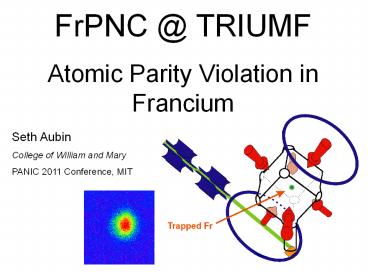FrPNC @ TRIUMF - PowerPoint PPT Presentation
Title:
FrPNC @ TRIUMF
Description:
Answer: Electromagnetic moment produced by a toroidal current. Time-reversal conserving. PNC toroidal current. Localized moment, contact interaction. – PowerPoint PPT presentation
Number of Views:110
Avg rating:3.0/5.0
Title: FrPNC @ TRIUMF
1
FrPNC _at_ TRIUMF Atomic Parity Violation in Francium
Seth Aubin College of William and Mary PANIC 2011
Conference, MIT
2
FrPNC collaboration
S. Aubin (College of William and Mary) J. A.
Behr, K. P. Jackson, M. R. Pearson (TRIUMF) V. V.
Flambaum (U. of New South Wales, Australia) E.
Gomez (U. Autonoma de San Luis Potosi, Mexico) G.
Gwinner, R. Collister (U. of Manitoba) D.
Melconian (Texas AM) L. A. Orozco, J. Zhang (U.
of Maryland at College Park) G. D. Sprouse (SUNY
Stony Brook) Y. Zhao (Shanxi U., China)
Funding
3
Atomic Parity Violation Basic Processes
e-
e-
?
N
N
Standard Electromagnetic Interaction (parity
conserving)
Z0 exchange Electron-Nucleon PNC (nuclear
spin-independent)
Intra-nuclear PNC Anapole moment (nuclear
spin-dependent)
4
Atomic Parity Violation Basic Processes
e-
e-
PNC
PNC
?
N
N
Standard Electromagnetic Interaction (parity
conserving)
Z0 exchange Electron-Nucleon PNC (nuclear
spin-independent)
Intra-nuclear PNC Anapole moment (nuclear
spin-dependent)
5
Motivation 1 Nuclear Spin-Independent PNC
Ae
The Hamiltonian for this interaction (infinitely
heavy nucleon approximation)
VN
Standard Model values for ?1, (p,n)
6
Motivation 1 Nuclear Spin-Independent PNC
For a nucleus with Z protons and N neutrons
Qweak weak charge of nucleus ? -N
2(?1,p Z ?1,n N)
Z0 exchange Electron-Nucleons PNC (nuclear
spin-independent)
7
Motivation 1 Testing and Probing the Weak
Interaction
Parity Violation Unique Probe of Weak
Interaction
Atomic PNC (APV) experiments test and constrain
the Standard Model
8
Motivation 1 Testing and Probing the Weak
Interaction
Parity Violation Unique Probe of Weak
Interaction
Atomic PNC (APV) experiments test and constrain
the Standard Model
9
Atomic PNC
? Electron wavefunction does not have a definite
parity !!!
10
Motivation 2 Nuclear Spin-Dependent PNC
e-
e-
Ae
Ve
Z0
VN
AN
N
N
Hyperfine Interaction NSI - Z0
exchange (nuclear spin-dependent)
Z0 exchange Electron-Nucleon PNC (vector)
(axial)
11
Whats an Anapole Moment ?
Answer Electromagnetic moment produced by a
toroidal current. ? Time-reversal conserving. ?
PNC toroidal current. ? Localized moment,
contact interaction.
12
Motivation 2 Nuclear Anapole Moment
For heavy atoms, the anapole moment term
dominates.
13
Motivation 2 Nuclear Anapole Moment
For heavy atoms, the anapole moment term
dominates.
14
Motivation 2 Nuclear Anapole Moment
For heavy atoms, the anapole moment term
dominates.
15
Motivation 2 Isovector Isoscalar Nucleon
Couplings
Cs anapole (Boulder) and low-energy nuclear PNC
measurements produce conflicting constraints on
weak meson-nucleon couplings. (Desplanques,
Donoghue, and Holstein model)
Need to understand nuclear structure better.
16
Motivation 2 Isovector Isoscalar Nucleon
Couplings
Cs anapole (Boulder) and low-energy nuclear PNC
measurements produce conflicting constraints on
weak meson-nucleon couplings. (Desplanques,
Donoghue, and Holstein model)
Francium isotopes provide orthogonal constraints
!!!
Behr and Gwinner, J. Phys. G 36, 033101 (2009)
17
FrPNC program Atomic PNC Experiments in Francium
- Fr is the heaviest of the simple (alkali
atoms). - ? Electronic structure is well
understood. - ? Particle/nuclear physics can be
reliably extracted. - Fr has large (relatively) PNC mixing.
- ? ?PNC 10-10 is still really really
small were going to need a lot of Fr. - Fr does not exist sufficiently in nature.
18
Atomic PNC in Fr (NSI)
EStark
k
Fr atoms (trapped)
BDC
M1 is strongly suppressed.
19
Anapole Moment in Fr
New Method Anapole can be measured by driving a
parity forbidden E1 transition between two
hyperfine states with ?F?1, ?mF?1.
?/2 pulse preparation the atoms are prepared in
a 50/50 superposition of the initial and final
states (equivalent to interference amplification)
before application of the microwave driving
E-field.
20
Anapole Moment in Fr
New Method Anapole can be measured by driving a
parity forbidden E1 transition between two
hyperfine states with ?F?1, ?mF?1.
?/2 pulse preparation the atoms are prepared in
a 50/50 superposition of the initial and final
states (equivalent to interference amplification)
before application of the microwave driving
E-field.
21
Anapole Moment in Fr
New Method Anapole can be measured by driving a
parity forbidden E1 transition between two
hyperfine states with ?F?1, ?mF?1.
?/2 pulse preparation the atoms are prepared in
a 50/50 superposition of the initial and final
states (equivalent to interference amplification)
before application of the microwave driving
E-field.
22
Simulating Fr Anapole with Rb
180 ms coherence time in blue-detuned dipole
trap (?/2 pulse with Rb)
Data by D. Sheng (Orozco Group, U. of Maryland)
23
FrPNC Current Status
Present Construction of an on-line, shielded
laser laboratory at TRIUMF with 100 db RF
suppression.
Fall 2011 (14 shifts in December) Installation
of high efficiency MOT (from U. of Maryland).
2012 Physics starts !!! Hyperfine anomaly
(Pearson), 7S-8S M1 (Gwinner), Anapole (Orozco),
optical PNC (Gwinner),
24
FrPNC collaboration
S. Aubin (College of William and Mary) J. A.
Behr, K. P. Jackson, M. R. Pearson (TRIUMF) V. V.
Flambaum (U. of New South Wales, Australia) E.
Gomez (U. Autonoma de San Luis Potosi, Mexico) G.
Gwinner, R. Collister (U. of Manitoba) D.
Melconian (Texas AM) L. A. Orozco, J. Zhang (U.
of Maryland at College Park) G. D. Sprouse (SUNY
Stony Brook) Y. Zhao (Shanxi U., China)
Funding































